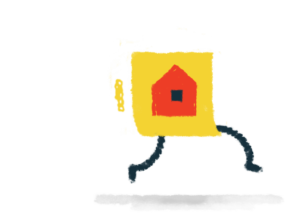At this stage of the participatory design process, the community is engaged with the production of spatial solutions. Three interconnected types of activity can be conducted with children:
- Visioning exercises;
- Inspiration and design thinking;
- Spatial design exercises.
These phases can also be conducted with partners, as well as youths and adults in the community. Engaging children through play is fundamental in all these activities.

Visioning exercises
Conducting visioning exercises with displaced children can be challenging, as some children may have witnessed traumatic events that have changed their attitude towards life and their future, making it hard for them to express what is asked of them. The process of imagination links to memories and therefore it can be shaped by the traumatic experiences.
Visioning exercises enable participants to imagine desired scenarios that enhance children’s wellbeing in urban contexts. Producing a vision of the future enables participants to recognise that they can shape their futures. The activities may begin with children developing individual visions, which are then discussed within the group to collectively arrive at one shared vision. Visioning outputs adds information that moulds the design of the space, such as its spatial experience, uses and users, the elements that form the space, and its colours.
The facilitator can guide participants’ visioning without imposing what to imagine through simple prompts, such as: What do you see when you think of this? Where are you? How did you access the space? What activities are you doing? Are you alone? If not, who is with you? What is the weather like? What is around you? What do you hear? Smell? Touch? Feel? etc.
Using artwork – drawing, music, dancing, singing, acting – to express their imaginations allows children to communicate ideas that may be difficult to express in words.
Inspiration and design thinking
Explaining to children and others what design is, and how the choice of design solution can impact people differently, is an important step. This can be achieved by discussing with participants case study examples from around the world. This will enable children to think about spatial design as a decision-making process that can change according to their needs. It may inspire them to think about how their environments can change. The case studies should present examples and concepts that are relevant to the intervention, and that can introduce values and ideas essential for good spatial design for children.
As we are working within the complex context of displacement, how to bring children’s identities to the space must be considered. Some other characteristics that could be embedded into children’s spaces include: personalised and expressive elements; nature; sensory stimulus; privacy from adults; safety; freedom; and security. Furthermore, the space must encourage imagination and growth.
During the design phase, the facilitator should discuss the programme and possible spatial configurations in detail with those who will be its main users. They should also research the typology of the building and understand how it can offer flexible spaces that can adapt over time. Looking at examples of similar solutions can help with envisioning alternative uses. Simulation tools are a great way to stimulate design thinking, through playful approaches, free from the pressure of needing to deliver a result to implement.
If the project is to design a school courtyard, for example, the facilitator could collect a range of examples that reflect important design values, showing pictures and explaining the key impacts of the courtyard designs. These examples should include both negative and positive elements and impact for the children. Children can then discuss what they like and dislike about each example, what would be good for their school courtyard, how the teachers might feel about it, whether boys and girls would use the same space, and so on.
Spatial design exercises
Spatial design exercises enable designing solutions for the intervention site to help achieve the participants’ vision. Designing solutions involves deciding on the spatial components, uses of space, spatial configurations, materials, colours, circulation and spatial experiences.
Activities should be conducted on site, as this helps participants to develop an understand of the space, which is key for them in visualising their ideas for the intervention. Whenever it is not possible to conduct activities on site, the built environment professional should take photographs and prepare a sketch or 3D visualisation for participants to use when co-designing. In spatial design exercises, using artwork such as drawing, painting, model making, performance and collage, allows children to visualise their ideas in ways they are familiar with, making it easier for them to express themselves. Depending on the age group of children, these exercises can achieve different levels of detail.
Children develop a sense of control when they can manipulate 3D models and change spaces that are usually fixed. 3D modelling is useful for experimenting with spatial design. Several mediums can be used, including building blocks, plasticine, cardboard boxes and recyclables. 3D modelling is especially interesting as it can happen at different scales. The one-to-one (human) scale can be used to test and discuss some of the design choices, such as the height of a chair.
Using digital gaming for spatial design empowers children. Many children of different educational backgrounds play video games. Even in the most difficult settings, parents tend to have smartphones that children can use. Even when children do not play video games, they are attracted to these tools. Digital gaming is a tool of communication that children are usually experts in, reversing the power relations between children and adults.
Elements of play and fun in spatial design exercises are crucial for children not to feel pressured to deliver a ‘perfect’, ‘final’ or ‘common’ product. Engaging caregivers together with their children informs design and enables the children to be heard by adults.
The participation of infants and toddlers becomes crucial for an inclusive process, especially when developing a built intervention for these age groups. Engaging caregivers and toddlers together in design exercises allows an understanding of how infants, who are usually accompanied by their caregivers, interact with and use the space. Additionally, observing young children and their caregivers may provide a clearer understanding of how to better design the intervention.
The following tools can be used for the participatory spatial design exercises.
Throughout these participatory activities, facilitators can mediate between the child and adult participants, and other key actors, such as local government. This can be achieved by inviting municipal staff or elected officials to join public design consultations. If needed, facilitators can reach out to local government and consult directly by creating a tailored design consultation.
After conducting a number of participatory design activities, the facilitators analyse the results to develop the preliminary design. Ideally, the activities will have already identified clear design solutions for the designers to organise into a visual representation for the design consultation. This may be a good time to conduct a technical survey of the site, to ensure that the suggested design solutions can be accommodated in the available space.
When children’s input cannot be easily implemented, their contribution can be included in creative ways. For example, if children proposed building a spaceship, the design could use outer space as a theme, perhaps designing a spaceship-shaped playground. At the same time, being transparent with children about the restrictions for the intervention can help them to suggest ideas that are feasible. When participants know what the limits are, they are more likely to make practical decisions about how to use available resources, and to be willing to compromise on what is less important.
Transparently communicating budget restrictions to children when engaging them in co-design activities is mentioned in the report ‘Making space for children: Planning for post-disaster reconstruction with children and their families’ by Save the Children.
The preliminary design is presented back to the community for another round of feedback, using clear visualisations such as 3D drawings, digital and/or physical models. This validation session can happen as a public design consultation, or in a workshop setting with children and their caregivers. If not already directly involved, engaging local authorities in the validation of the preliminary design is a fundamental step in ensuring their support, and later securing building permits.
The further feedback gained contributes to finalising the preliminary design, and the move to technical design.



